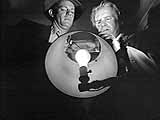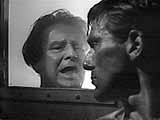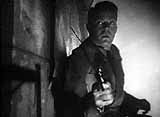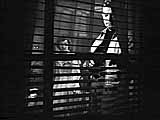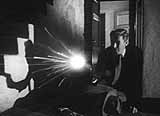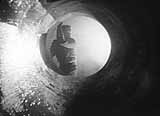






| Kino Releases Three Anthony Mann Film Noir Classics to Video by Gary Johnson | |
Go to: |
Kino International recently released a set of three movies in their "Noir: The Dark Side of Hollywood" series. These movies include T-Men, Raw Deal, and He Walked by Night. Film noir enthusiasts will have no trouble instantly identifying all three movies as Anthony Mann movies (even though his contribution to He Walked by Night is uncredited). |
T-Men 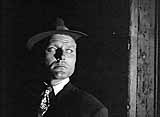 Hit man Charles McGraw slides from the shadows.
Raw Deal 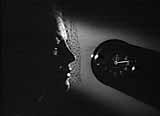 Claire Trevor finds Father Time is one tough customer.
He Walked by Night 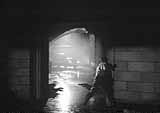 Richard Basehart flees across an alley.
|
Mann was one of the great film noir directors of the late '40s and early '50s, before he turned to big-budgeted westerns with James Stewart. All of his film noirs pack a wallop, with fast-paced action and shocking violence. But the real glue that holds this set together comes from cinematographer John Alton, who photographed all three movies. Alton was one of the great cameramen of the film noir period and these three movies represent some of Alton's best work. Alton was rarely satisfied with conventional camera setups. As you'll find in these three movies, Alton continuously searched for intriguing camera angles. He was particularly fond of low angle shots. When someone got thrown down a hallway or into an alley, Alton loved to place his camera just inches off the ground to catch that wince of pain as the poor soul smacked the pavement. When Dennis O'Keefe gets thrown out of a gambling joint in T-Men, the camera brings us just inches away as he bounces off the asphalt and rolls out of the path of an oncoming car.
Alton always strove to reinforce the depth of the images by arranging actors in several planes in front of the camera. Whereas many directors of cinematography would simply arrange for two actors to be equal distance from the camera, Alton loved to give us one actor up close, preferrably turned sideways to the camera, while another actor stood in the background. In T-Men, we see Dennis O'Keefe's profile as he grimaces in pain as Charles McGraw twists (and threatens to break) his fingers. And in Raw Deal, Raymond Burr lights some candles while O'Keefe gets the drop on him and steps into the back of the room.
Alton's desire to create the illusion of depth also meant he used objects in a room to break up the frame, such as the light shade in T-Men: Alton shoots the scene by placing the camera below the lamp as O'Keefe and Wallace Ford inspect a counterfeit dollar, shooting up through the lamp shade and right into their faces. And in Raw Deal we get one of the hallmark shots of film noir: O'Keefe stands behind a venetian blind, the room sliced into horizontal slats of light as he peers down at the street.
Alton also loved fog and steam and smoke. In He Walked by Night, Richard Basehart flees across a foggy alley as a car's headlights swing toward him, and later he struggles to get out of the Los Angeles sewer by pushing open a manhole cover--but smoke from a tear gas bomb envelopes him. And in Raw Deal, O'Keefe gets cornered in an alley as a thick fog threatens to obscure the action. In T-Men, several scenes take place in a steam bath, while the camera slips in close to show the beads of perspiration on the men's faces.
Alton also loved shafts of light, such as the burst of light, like a lighthouse beacon, that blasts through the small window on the door of the steam bath in T-Men. And in Raw Deal, Alton gives us stunningly beautiful shafts of moon light that break through the forest tree tops and cascade down a hillside. |
|
A strong case could be made for John Alton as the real auteur of these movies. At times the expressionistic style runs against the subject matter. In both, He Walked by Night and T-Men the movies take an ostensibly semi-documentary approach, giving us a behind-the-scenes point of view as the police force (in the former) and treasury agents (in the latter) work to put crooks behind bars. We even get voice-over narration leading us through the story, Dragnet style. But the cinematography always reminds us that we aren't really watching a documentary, as Alton bathes the characters in sharp, dramatic lighting from the side (with beams of light aimed perpendicular to the camera). For example, in a masterpiece of composition from T-Men, Charles McGraw's face slides forward out of the darkness, as if he were part demon. We then watch as he coldly steps from the darkness and pulls the trigger of his gun. Alton's style owes nothing to the documentary or the newsreel. His precursors instead include the artful compositions of John Ford and Orson Welles, not to mention the expressionistic German filmmaking of the silent era. Alton's used the same approach for T-Men and He Walked by Night as he did for Raw Deal, which doesn't use a narrator and tells its story strictly from the side of the crooks. As a result Raw Deal works the best dramatically. It's a tightly woven tale of fatalistic action. Several images jump to mind immediately, such as Claire Trevor's face in profile as a clock continues to tick in the background. Alton frames the clock beside her face as the ever present lighting from the side casts an angular shadow along the wall. The composition tells us clearly and elegantly what no narrator could say: Father Time is one tough customer and he's not going to let Trevor and her lover O'Keefe escape without one last fight. Or try the movie's stunning climax as O'Keefe and Raymond Burr duke it out as the room catches fire and Burr tries to push O'Keefe into the flames. For these reasons, Raw Deal is the real gem of these releases and it's the one movie to buy if you can afford only one video in this set. But be sure to see all three movies. These are gorgeous movies that serve as testament to the power of black -and-white photography. But these movies aren't just showcases for flashy images. Director Anthony Mann was a master of pacing, and he guides you through the narratives at breakneck speed, while delivering some nice bits of characterization along the way. In He Walked by Night, for example, Richard Basehart is a cop killer, but Mann also guides us into his apartment, where we see Basehart caring for his dog. We get to know Basehart and feel the tragedy that puts crook Basehart in a situation where he has to kill in order to survive. (Was Mann responsible for these nice bits of characterization or was the movie's credited director, Alfred Werker, responsible?) And in T-Men, Mann shows us the close friendship that develops between two treasury agents (O'Keefe and Alfred Ryder) who go undercover to nab a ring of counterfeiters. In a horrifying scene, we watch as Ryder is killed while his partner (O'Keefe) stands by, powerless to help him. To protect his own identity and ensure he doesn't get killed also, O'Keefe must even participate in the killing. Mann builds the scene with startling close-ups of the friends' faces, as they realize what must happen and they accept the fate. But to say these movies are Anthony Mann movies isn't quite accurate. This set of film noir classics presents as good an argument as any that filmmaking is a collaborative art and that the contribution of the cinematographer can easily be as important as the director's. They also serve as a fitting epitaph for the career and artistry of John Alton, who died in 1996. T-Men, Raw Deal, and He Walked by Night are available from Kino International as part of the "Noir: The Dark Side of Hollywood" series. The videos have a suggested list price of $29.95 each.
Photo Credits: © 1996 Kino International Corp. |
